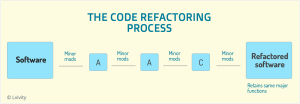Welcome to the world of code refactoring, where readability and performance reign supreme! In the fast-paced realm of programming, it’s essential for developers to constantly upgrade their codebase. But fear not! We’ve got your back with a treasure trove of tried-and-true techniques that will take your software craftsmanship to new heights. Brace yourself as we embark on an exhilarating journey filled with practical tips and mind-blowing insights into enhancing both readability and performance. Get ready to refactor like a pro and watch your code transform from good to exceptional. Let’s dive in!
What is Refactoring?
Refactoring code means making changes to the structure or organization of your code without changing its behavior. These changes can make your code more readable, easier to maintain, and more efficient.
There are many different refactoring techniques, but some common ones include:
Extracting methods: This involves taking a section of code and turning it into a separate method. This can make your code more readable and easier to reuse.
Renaming variables: This helps make your code more understandable by giving variables names that describe their purpose.
Extracting classes: This helps keep your code organized by moving related functionality into its own class.
In general, refactoring is about making small, incremental changes to your code that improve its overall quality. By regularly refactoring your code, you can make it easier to work with and less likely to contain errors.
Why Should You Refactor Your Code?
When it comes to code, there is always room for improvement. No matter how proud you are of your code, chances are there are ways to make it better. That’s where code refactoring comes in.
Refactoring is the process of improving the design of existing code without changing its functionality. It’s a way to make your code simpler, cleaner, and more robust. And, as an added bonus, refactoring can also improve performance.
There are many reasons why you should refactor your code. Here are just a few:
- To improve readability and maintainability
Well-designed code is easy to read and understand. This makes it easier to work with, debug, and extend. By contrast, poorly designed code can be very difficult to work with – even for the original author! Refactoring can help improve the readability of your code so that it is easier to maintain in the long run.
- To avoid technical debt
Technical debt is the accumulation of small design decisions that make your code harder to work with over time. If left unaddressed, technical debt will eventually lead to problems such as code rot or server outages. Refactoring can help you avoid these problems by keeping your code clean and well-designed from the start.
- To improve performance
Poorly designed code can be slow and inefficient. By contrast, well-designed code tends to be faster and more efficient. Refactoring can help you make sure that your code is optimized for performance, so that it runs faster and more reliably.
Ultimately, refactoring your code is an investment. It may take time to clean up your codebase, but the benefits are worth the effort. So if you want to improve the quality of your code, consider taking some time to refactor it!

Different Types of Refactoring Techniques
There are dozens of different code refactoring techniques that can be used to enhance the readability and performance of your code. However, not all of these techniques are equally effective or applicable in every situation. Here is a brief overview of some of the most popular code refactoring techniques:
- Extract Method: This technique is used to extract a section of code into a separate method. This can make your code more readable and easier to maintain.
-
Rename Variable: This technique is used to rename variables for clarity. This can make your code more readable and easier to understand.
-
Replace Conditional with Polymorphism: This technique is used to replace complex conditional statements with polymorphism. This can make your code more reliable and easier to modify.
-
Inline Method: This technique is used to inline a method call into the caller method body. This can improve performance by avoiding unnecessary method calls.
-
Replace Magic Numbers with Constants: This technique is used to replace magic numbers (literal values that have no specific meaning) with constants (named values that have a specific meaning). This can improve the readability and maintainability of your code .
-
Introduce Parameter Object: This technique is used to introduce a parameter object to replace multiple parameters in a method. This can improve the readability and maintainability of your code.
-
Extract Interface: This technique is used to extract an interface from a class or group of classes. This can make your code more modular and easier to test.
Breaking Down a Long Method into Shorter Ones
It is always a good practice to break down a long method into shorter ones. This not only enhances the readability of the code but also improves performance. There are various techniques that can be used to achieve this.
One common technique is to use the extract method refactoring. This entails taking a section of code from a long method and extracting it into a new method. The extracted code should be self-contained and serve a specific purpose. It should also be easy to understand and test.
Another useful technique is known as the split phase refactoring. This involves breaking up a long method into two or more shorter methods. The first method would contain the initial processing, while the second method would handle the remaining tasks. This division of labor can make the code more readable and easier to maintain.
It is sometimes possible to replace a long method with several smaller ones that each perform a specific task. This approach can improve readability by making it easier to see the overall structure of the code. It can also lead to better performance, since each small method can be optimized independently.
Removing Repetitive Code
When it comes to code refactoring, one of the most important things to keep in mind is removing repetitive code. Repeating code not only makes your code more difficult to read, but it can also lead to errors and decreased performance.
There are a few different ways that you can remove repetitive code:
- Combine similar code blocks: If you have two or more code blocks that are doing similar things, you can combine them into one block of code. This will simplify your code and make it easier to read.
-
Extract common functionality into functions or methods: If you have repetitious code that is used in multiple places, you can extract it into a separate function or method. This way, you can call the function or method whenever you need the functionality, instead of having to copy and paste the code each time.
-
Use loops: Loops are a great way to avoid repetition in your code. If you find yourself writing the same piece of code multiple times, try using a loop instead. This will enable you to execute the code once for each item in a given list or collection.
-
Simplify conditional statements: If you have complex conditional statements, such as nested if statements, try simplifying them. You can do this by extracting parts of the condition into separate variables or methods. This will make your conditional statements easier to read and understand.
-
Remove unused variables and dead code: Unused variables
and dead code (code that is never called) can make your code harder to read and maintain. Always make sure that your variables are only declared when they are needed and that any dead code is removed from the project.
Enhancing the Performance and Readability with Other Techniques
There are other techniques that can be used to improve the readability and performance of your code. One such technique is to use comments. Comments can help to explain what your code is doing and make it more understandable. Another technique is to use white space effectively. Indenting your code and using blank lines can help to make it more readable. You can also use shorter variable and function names to improve readability.
Additionally, you can use certain design patterns that promote code performance. For example, using the single responsibility principle (SRP) can help to split up long functions into smaller ones and make your code more efficient. Additionally, caching data and using lazy loading can help to improve execution times when dealing with large data sets. Finally, use library functions whenever possible instead of writing your own codes so that you can benefit from other developers’ experience.
There are several other techniques that can be used to enhance the readability and performance of code. One such technique is ‘code comments’. Comments can be used to explain the purpose of a particular section of code, or to provide information about how a particular function works.
Another technique that can be used to improve performance is ‘code optimization’. This involves making changes to the code so that it runs faster and uses less memory. Code optimization is a technical process that should only be carried out by experienced developers.
Another way to improve the readability and performance of code is to use ‘coding conventions’. Coding conventions are a set of guidelines that specify how code should be written. For example, they may dictate how variables should be named, or how functions should be organized. By following coding conventions, developers can make their code more consistent and easier to read.
Coding Guidelines for Refactoring
When refactoring code, it is important to adhere to coding guidelines in order to improve the readability and performance of the code. Some tips for doing this include:
-Using descriptive variable and function names
– Organizing code into logical blocks
– Keeping code simple and concise
– eliminating redundancy
– following standard coding conventions
Conclusion
Code refactoring techniques can be incredibly helpful when it comes to improving the readability and performance of your codebase. By testing which refactoring methods work best for you, you can optimize your code for better overall performance. Reorganizing functions, using naming conventions, creating templates and reducing duplication are just a few of the ways that developers can make their codes more streamlined and efficient. Ultimately, investing in this type of quality assurance will help ensure successful software development projects going forward.

